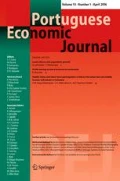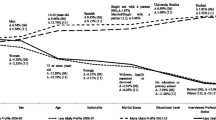Abstract
This paper analyzes the relationship between individual health status and labor force participation using the first wave of the Colombian Longitudinal Survey. The empirical modeling strategy accounts for the presence of potential endogeneity between these two variables. The results show that there is a positive relationship between health and labor force participation in both directions, indicating that better health is likely to lead to a higher probability of participation in the labor market, but also that individuals who participate in the labor market are more likely to report better health. Interesting differences are uncovered when comparing the results by gender and/or age groups. For instance, for younger females, health status and higher education positively affect the probability of labor participation, whereas having children under the age of 5 and being married reduce their probability of participation. Our findings also highlight the importance of public policy to guarantee good health conditions of the population which could also have a positive impact on labor productivity and consequently on long-run economic growth.

Similar content being viewed by others
Notes
We follow closely Cai and Kalb’s (2006) notation.
Strata one to four include low and middle income households. The survey excludes strata five and six, which correspond to the highest socioeconomic strata.
It is important to mention that, for statistical purposes, the Colombian National Department of Statistics (DANE for its Spanish acronym) considers that the working age population corresponds to those individuals aged 12 years and over in urban areas. Also, in our sample, there are only two individuals younger than 15 years old, which is the age commonly used as the minimum age threshold for international comparisons. In addition, less than 1 % of the individuals in our sample are under 20 years old.
The choice of age groups was made taking into account that labor participation increases with age up to around 40 years when it starts to decline. The evidence presented in this paper supports this choice.
In this paper we use the definition of occupation provided by the Colombian Statistical Department (DANE), according to which occupied people are those worked at least one paid (in kind of in cash) hour in the reference week, those who did not work during the reference week but had a job, and unpaid family workers who worked in the reference week at least 1 hour.
It is important to point out that self-assessed health could be used to rationalize labor force participation. Cai and Kalb (2006) state that rationalization could make the health variable endogenous and its effect could be overestimated.
An alternative estimation method could be three-stage least squares which estimate the equations simultaneously and allows complete simultaneity. The results are similar to those obtained with IV-2SLS. Given that the estimators are inconsistent when errors are heteroskedastic, as in this case, we decided against this estimation method. In addition, another method could be the bivariate probit. However, this method does not allow us to consider neither full simultaneity nor the four categories in the health status variable. Nevertheless, we estimated bivariate probit models assuming two categories of health (good and poor). The results of these alternative estimations are not reported here but are available upon request.
In Colombia the health social system consists of three main regimes, each with different health services: Contributory, non‐contributory (subsidized), and special (e.g., armed forces and national police). The contributory regime operates as an insurance system that offers a basic health plan. It covers workers with a work contract, pensioners and freelancers. The non-contributory or subsidized regime covers the poorest and most vulnerable people in the country and is funded with public resources (Melo and Ramos 2010).
“Familias en acción” is a government program addressed to families in poverty and vulnerability, which delivers conditional monetary transfers in order to supplement incomes and improve health and education for children under 18.
In these estimations, each equation is separately estimated and all exogenous variables are used as instruments (see Wooldridge 2006).
Appendix B presents the tests for the joint significance of the instruments as well as the tests for endogeneity.
We also consider other measures of labor market activity. For example, we excluded from our original definition, unpaid family workers. Then we excluded those who work less than 24 hours (this is half the working hours a person can legally work per week in Colombia). The results are qualitatively the same as those of our main specification. To save space, results are not presented here, but are available upon request.
The threshold parameters estimated in all the models are statistically different from one another; therefore, we maintained the four categories for the dependent variables in all the models. A Wald test was used to test the difference among the threshold parameters. The results of the tests, as well as the marginal effects for all models, may be obtained from the authors upon request.
For Australia, Cai and Kalb (2006) find a positive relationship between being in the labor force and self-assessed health for older women, indicating different working conditions between the two countries.
References
Amador D, Bernal R, Peña X (2013) The rise in female participation in Colombia: fertility, marital status or education? Ensayos sobre Política Económica 31(71):54–63
Arango LE, Posada CE (2005) Labour participation in Colombia. Appl Econ 37(16):1829–1838
Bartel A, Taubman P (1979) Health and labor market success: the role of various diseases. Rev Econ Stat 61(1):1–8
Becker GS (1964) Human capital. Columbia University Press, Nueva York
Belachew T, Kumar A (2014) Examining association between self-assessed health status and labour force participation using pooled NHS data. Australian Bureau of Statistics, Research Papers, ABS Catalogue no. 1351.0.55.049
Brown P, Vickerstaff S (2011) Health Subjectivities and labor market participation pessimism and older workers’ attitudes and narratives around retirement in the United Kingdom. Res Aging 33(5):529–550
Cai L (2010) The relationship between health and labour force participation: evidence from a panel data simultaneous equation model. Labour Econ 17(1):77–90
Cai L, Cong C (2009) Effects of health and chronic diseases on labour force participation of older working-age Australians. Aust Econ Pap 48(2):166–182
Cai L, Kalb G (2006) Health status and labour force participation: evidence from Australia. Health Econ 15(3):241–261
Cawley J, Ruhm C (2012) The economics of risky health behaviors. In: McGuire TG, Pauly MV, Pita Barros P (eds) Handbook of health economics, vol 2. Elsevier, New York, pp 95–199
Contreras D, Plaza G (2010) Cultural factors in women’s labor force participation in Chile. Fem Econ 16(2):27–46
Currie J, Madrian BC (1999) Health, health insurance and the labor market. In: O. Ashenfelter and D. Card (eds.), Handbook of labor economics, edition 1, volume 3, chapter 50, pages 3309–3416, Elsevier
Cutler DA, Lleras-Muney A (2010) Understanding differences in health behaviors by education. J Health Econ 29(1):1–28
Frijters P, Johnston DW, Shields MA. et al. (2010) Mental health and labour market participation: Evidence from IV panel data models. IZA DP No. 4883
Grossman M (1972) The demand for health: A theoretical and empirical investigation. Columbia University Press, National Bureau of Economic Research, New York
Grossman M (2006) Education and nonmarket outcomes. In: E. A. Hanushek and F. Welch (eds.). Handbook of the economics of education, vol. 1, pp. 577–633, Elsevier
Hahn BA (1993) Marital status and women’s health: the effect of economic marital acquisitions. J Marriage Fam 55(2):495–504
Harris A (2009) Diabetes, cardiovascular disease and labour force participation in australia: an endogenous multivariate probit analysis of clinical prevalence data. Econ Rec 859(271):472–484
Kalwij AS, Vermeulen FMP (2008) Health and labour force participation of older people in Europe: what do objective health indicators add to the analysis? Health Econ 17(5):619–638
Laplagne P, Glover M, Shomos A et al (2007) Effects of health and education on labour force participation. productivity commission staff working paper, Melbourne. [It is not by the author(s)]
Maddala GS (1983) Limited-dependent and qualitative variables in econometrics. econometric society monographs no. 3. Cambridge University Press, Cambridge
Melo L, Ramos J (2010) Algunos aspectos fiscales y financieros del sistema de salud en Colombia. Revista del Banco de la República 83(994):16–33
Qin L, Wang Z (2015) Impact of health status and related factors on labor market positions of urban mature Chinese. J Lab Res 36(2):224–231
Schultz TW (1961) Investment in human capital. Am Econ Rev 51(1):1–17
Stern S (1989) Measuring the effect of disability on labor force participation. J Hum Resour 24(3):361–395
Vecchio N, Mihala G, Sheridan J, Hilton MF, Whiteford H, Scuffham PA (2014) A link between labor participation, mental health and class of medication for mental well-being. Econ Anal Policy 44(4):376–385
Winkelmann R, Boes S (2006) Analysis of microdata. Springer, Berlin
Wooldridge JM (2006) Introductory econometrics: a modern approach, 3rd edn. Thomson South-Western, Mason
Acknowledgments
We would like to thank an anonymous referee for helpful comments and suggestions. We also want to thank Ximena Cadena, Director of the ELCA Project, for the information about the survey. We are also grateful to Luis Eduardo Arango, Jesús Otero, Rainer Winkelmann, and Héctor Zárate for their comments and suggestions. We also wish to thank Carmen Cecilia Delgado, Helena González, and Sonia Salazar for their excellent research assistance. The opinions expressed herein are those of the authors and do not necessarily reflect the views of Banco de la República or its Board of Directors.
Author information
Authors and Affiliations
Corresponding author
Appendices
Appendix A Variables used in the model
Appendix B
About this article
Cite this article
Iregui-Bohórquez, A.M., Melo-Becerra, L.A. & Ramírez-Giraldo, M.T. Health status and labor force participation: evidence for urban low and middle income individuals in Colombia. Port Econ J 15, 33–55 (2016). https://doi.org/10.1007/s10258-016-0116-7
Received:
Accepted:
Published:
Issue Date:
DOI: https://doi.org/10.1007/s10258-016-0116-7




